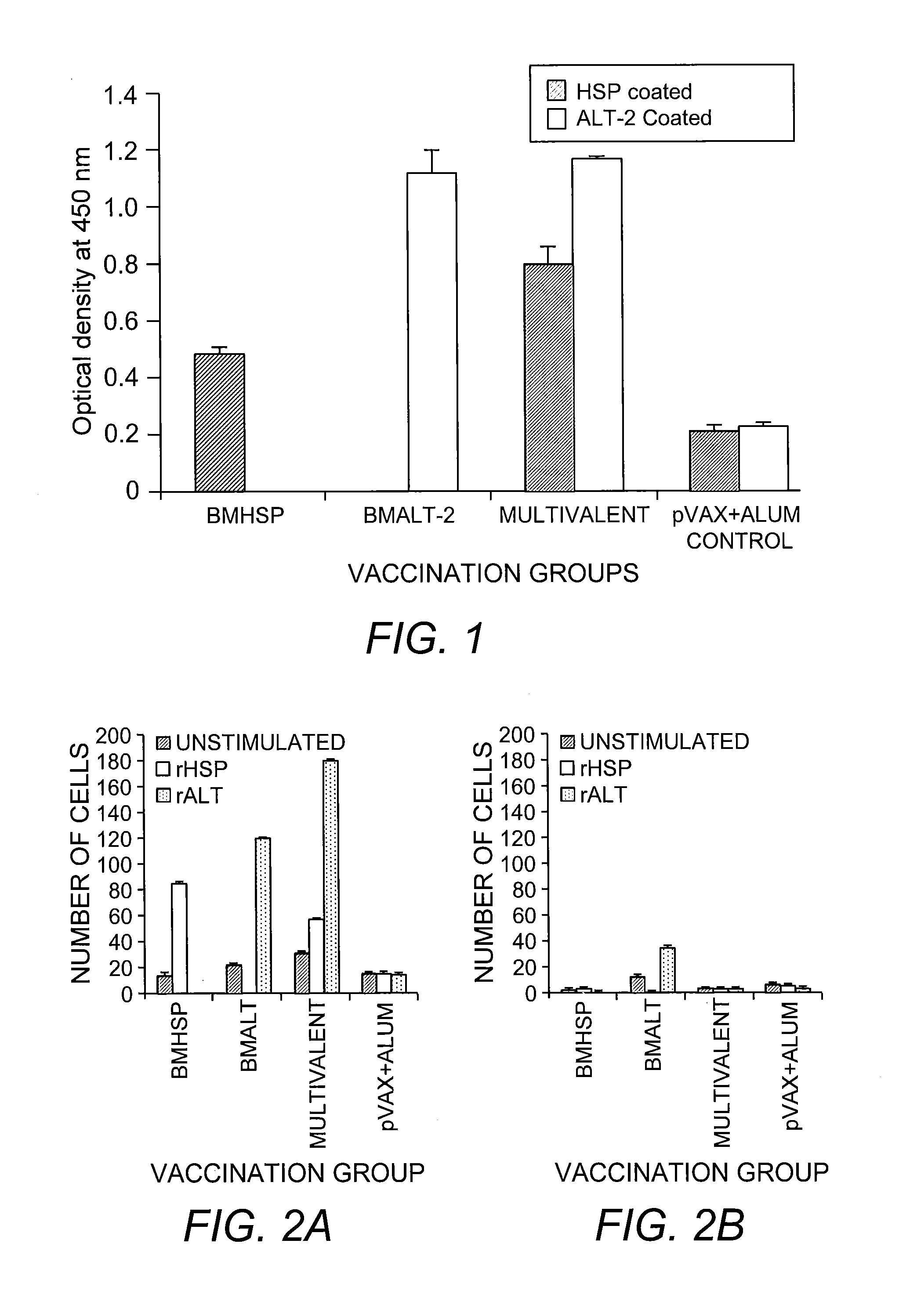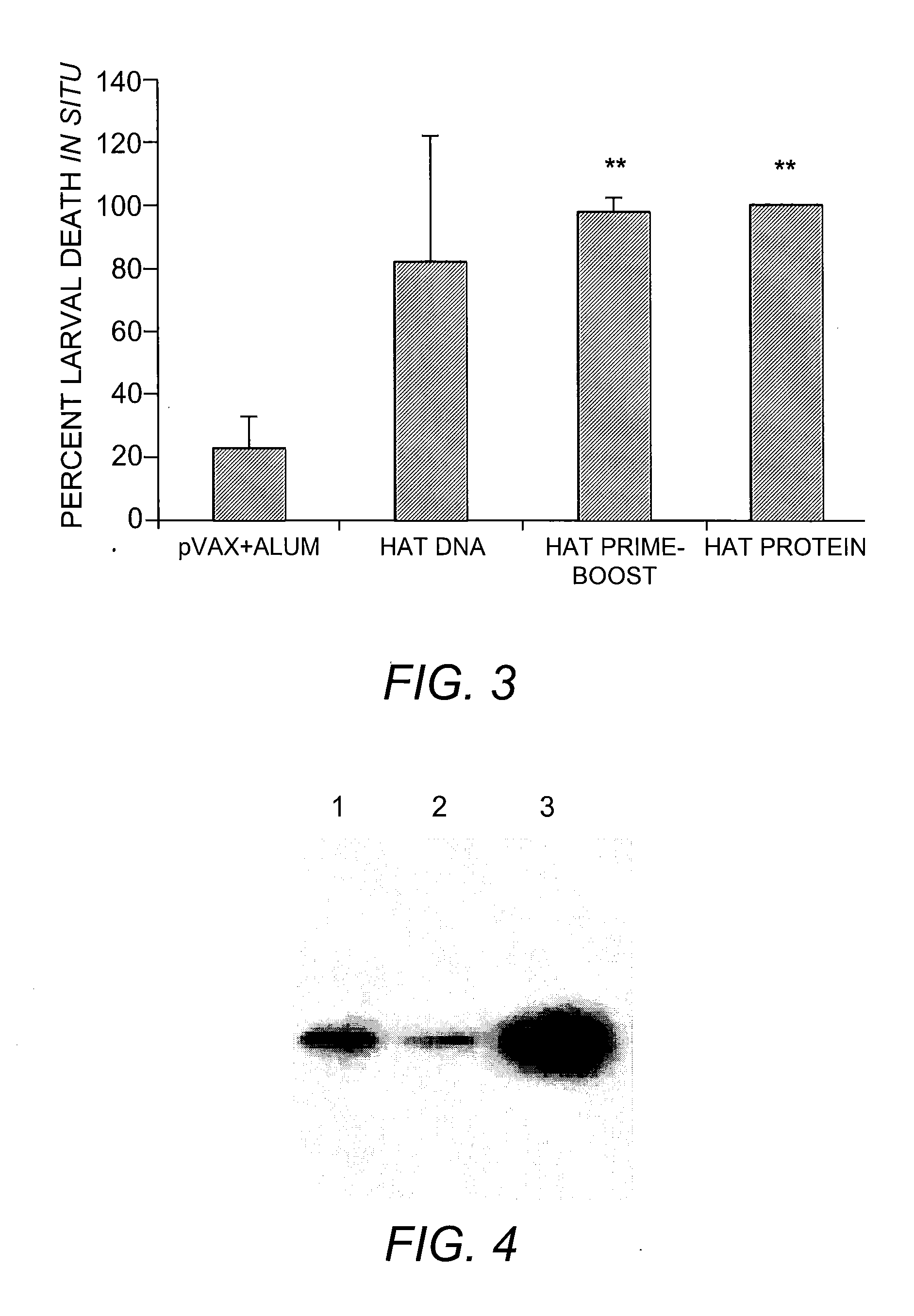Multivalent Vaccine for Filariasis
a vaccine and vaccine technology, applied in the field of multivalent vaccines for filariasis, can solve the problems of difficult to fight against this infection with a single antigen vaccine, lack of effectiveness of mass drug administration,
- Summary
- Abstract
- Description
- Claims
- Application Information
AI Technical Summary
Benefits of technology
Problems solved by technology
Method used
Image
Examples
example 1
Small Heat Shock Protein Vaccine
[0049]Parasites. B. malayi L3s were obtained from the NIAID / NIH Filariasis Research Reagent Resource Center (FR3) at the University of Georgia, Athens, Ga.
[0050]Human Sera Samples.
[0051]About 10 ml of blood samples were collected from the following clinical groups of subjects (1) Endemic normal (EN) subjects, these were individuals who were asymptomatic and non-microfilaraemic; (2) asymptomatic microfilaraemic subjects (Mt) who had circulating microfilaria in their blood and were identified by microscopic examination of their night blood smears; (3) Chronic Pathology (CP) patients include those subjects who exhibited lymph edema and other chronic clinical symptoms of filariasis and (4) Non-endemic normal subjects (NEN) who lived in non-endemic areas and had no circulating parasites or antibodies and showed no evidence of any filarial disease. Sera were separated from these blood samples and were stored at −80° C. until use.
[0052]Expression and Purific...
example 2
rBmALT-2+rBmHSP Multivalent Vaccine
[0110]Parasite.
[0111]Brugia malayi L3s were obtained from the NIAID / NIH Filariasis Research Reagent Resource Center (FR3) at the University of Georgia, Athens, Ga.
[0112]Construction of Monovalent and Multivalent DNA Vaccines.
[0113]Monovalent DNA vaccine was composed of Bmhsp or Bmalt-2 in pVAX1 vector. To prepare the monovalent vaccine, codon optimized Bmhsp or Bmalt-2 genes were cloned into the eukaryotic expression vector pVAX1 (Invitrogen, Carlsbad, Calif.) using insert-specific primers (Gnanasekar, et al. (2004) supra). The multivalent vaccine was composed of Bmhsp and Bmalt-2 genes in the same pVAX1 vector. Codon optimized Bmhsp gene was first cloned into pVAX1 vector with no stop codon in the reverse primer (5′-CCG GAA TTC TCA CTT GTC GTT GGT G-3′; SEQ ID NO:24) but contained a PstI site. Codon optimized Bmalt-2 gene was then inserted into this clone using gene specific primers (Gnanasekar, et al. (2004) supra). PCR parameters for all the thr...
example 3
BmVal-1+BmALT-2 Multivalent Vaccine
[0134]Sera.
[0135]Sera samples used in this study were from archived samples stored at the Mahatma Gandhi Institute of Medical Sciences, Sevagram, India. These samples were collected as part of epidemiological surveys in and around Wardha, an area endemic for lymphatic filariasis.
[0136]No demographic data was available to this study except that the sera samples were classified into microfilaremic (MF), chronic pathology (CP) or Endemic normals (EN) based on the detection of circulating parasites, parasite antigens or by evaluating clinical symptoms of lymphatic filariasis. Circulating microfilariae were detected in the blood of subjects according to known methods (Haslbeck, et al. (2005) Nat. Struct. Mol. Biol. 12:842-846; Yoo, et al. (2005) Biotechnol. Lett. 27:443-448). The presence of circulating antigen was detected using an Og4C3 kit and a WbSXP-based enzyme-linked immunosorbent assay (ELISA). Subjects with no circulating antigen or microfilari...
PUM
| Property | Measurement | Unit |
|---|---|---|
| Fraction | aaaaa | aaaaa |
| Fraction | aaaaa | aaaaa |
| Fraction | aaaaa | aaaaa |
Abstract
Description
Claims
Application Information
 Login to View More
Login to View More - R&D
- Intellectual Property
- Life Sciences
- Materials
- Tech Scout
- Unparalleled Data Quality
- Higher Quality Content
- 60% Fewer Hallucinations
Browse by: Latest US Patents, China's latest patents, Technical Efficacy Thesaurus, Application Domain, Technology Topic, Popular Technical Reports.
© 2025 PatSnap. All rights reserved.Legal|Privacy policy|Modern Slavery Act Transparency Statement|Sitemap|About US| Contact US: help@patsnap.com


